IIR数字滤波器设计
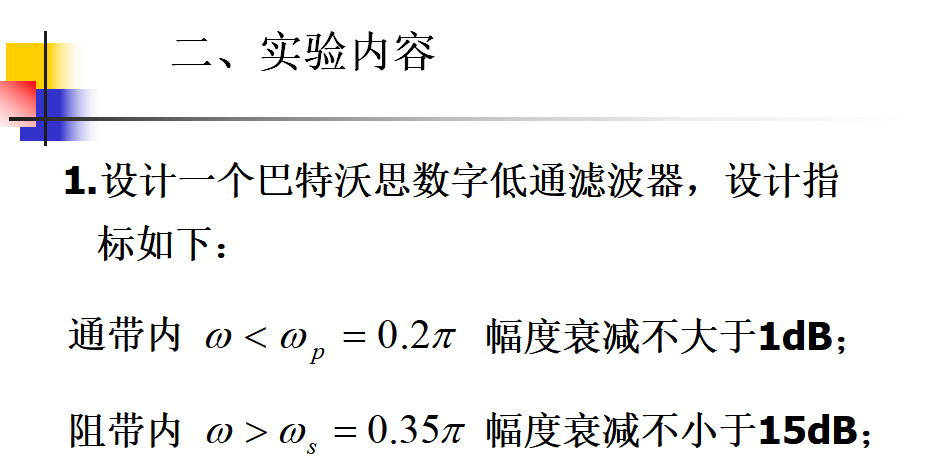
%实验三(1) 设计要求的数字滤波器 clc;clear; clear all; wp=0.2;ws=0.35;Ap=1;As=15; [N,fc]=buttord(wp,ws,Ap,As); %求出符合参数的滤波器阶数和截止频率 [B,A]=butter(N,fc); %得到滤波器H(z)的系数 [h,w]=freqz(B,A,1024); %计算模拟滤波器响应 plot(w/pi,20*log10(abs(h)/abs(h(1)))); title('wp=0.2π;ws=0.35π;Ap=1dB;As=15dB的巴特沃思数字低通滤波器'); grid on;xlabel('w/pi');ylabel('幅度(dB)'); axis([0,1,-30,0]) line([0,1],[-1,-1],'linestyle','--'); line([0,1],[-15,-15],'linestyle','--'); line([0.2,0.2],[-30,0],'linestyle','--'); line([0.35,0.35],[-30,0],'linestyle','--');
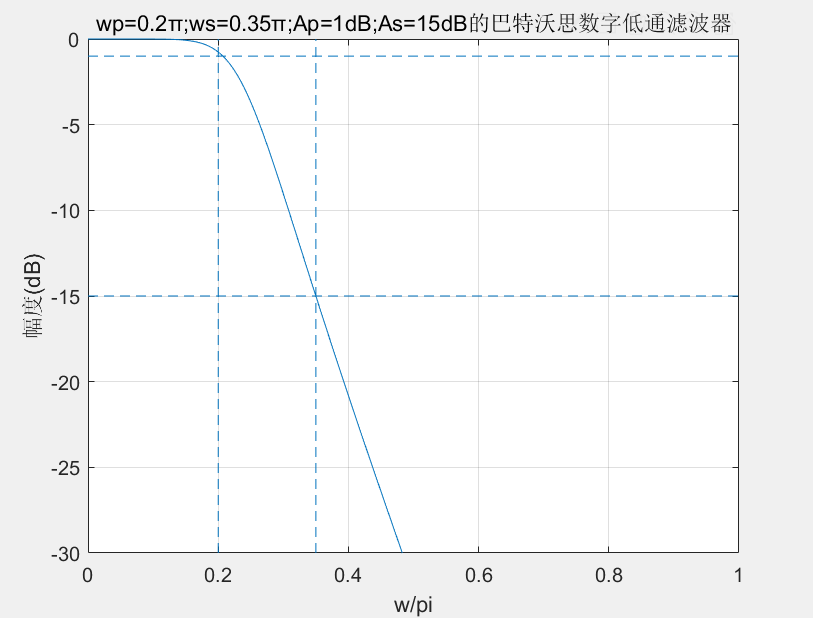
编制计算设计的数字滤波器幅度特性和相位特 性的程序,并进行实验验证。
%实验三(2) 数字滤波器的幅度特性与相位特性 clc; close all; wp=0.2;ws=0.35;Ap=1;As=15; [N,fc]=buttord(wp,ws,Ap,As); %求出符合参数的巴特沃思滤波器阶数和截止频率 [b,a]=butter(N,fc); %得到滤波器H(z)的系数 [h,w]=freqz(b,a,1024); %计算数字滤波器响应 subplot(2,1,1);plot(w/pi,abs(h));title('幅度响应'); %数字滤波器幅度特性 axis([0,1,0,1.2]);line([0.2,0.2],[0,1.2],'linestyle','--'); line([0.35,0.35],[0,1.2],'linestyle','--'); xlabel('w/pi');ylabel('幅度'); subplot(2,1,2);plot(w/pi,angle(h)/pi);title('相位响应'); %数字滤波器相频特性 axis([0,1,-1,1]);line([0.2,0.2],[-1,1],'linestyle','--'); line([0.35,0.35],[-1,1],'linestyle','--'); xlabel('w/pi');ylabel('相位/pi');
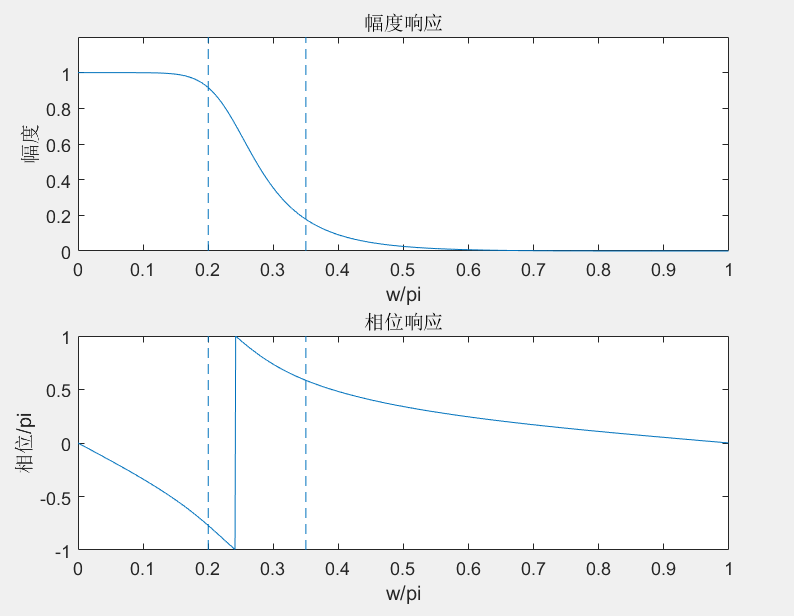
编制实现该数字滤波器程序并且实现数字滤波
%实验三(3) 实现各个频率的正弦波的数字滤波 clc; clear; close all; wp=0.2;ws=0.35;Ap=1;As=15; [N,fc]=buttord(wp,ws,Ap,As); %求出符合参数的巴特沃思滤波器阶数和截止频率 [b,a]=butter(N,fc); %得到滤波器H(z)的系数 [H,w]=freqz(b,a,1024); %计算数字滤波器响应 [h,n]=impz(b,a,30); w1=0.15*pi;w2=0.3*pi;w3=0.4*pi; x1=sin(w1.*n);x2=sin(w2.*n);x3=sin(w3.*n); %正弦波频率:通带、过渡带、阻带 figure subplot(3,2,1); stem(n,x1); title('通带正弦波'); %原通带正弦波 subplot(3,2,2); y1=conv(x1,h); stem(0:length(y1)-1,y1);axis([0,60,-1,1]); title('滤波后的通带正弦波'); subplot(3,2,3); stem(n,x2); title('过渡带正弦波'); %原过渡带正弦波 subplot(3,2,4); y2=conv(x2,h); stem(0:length(y2)-1,y2);axis([0,60,-1,1]); title('滤波后的过渡带正弦波'); subplot(3,2,5); stem(n,x3); title('阻带正弦波'); %原阻带正弦波 subplot(3,2,6); y3=conv(x3,h); stem(0:length(y3)-1,y3);axis([0,60,-1,1]); title('滤波后的阻带正弦波'); figure w4=0.6*pi;x4=sin(w4.*n); %验证滤波器的模拟截止频率,滤波后的幅度几乎全0 subplot(2,1,1); stem(n,x4); title('截止频率处的正弦波'); subplot(2,1,2); y4=conv(x4,h); stem(0:length(y4)-1,y4);axis([0,60,-1,1]); title('滤波后的正弦波');


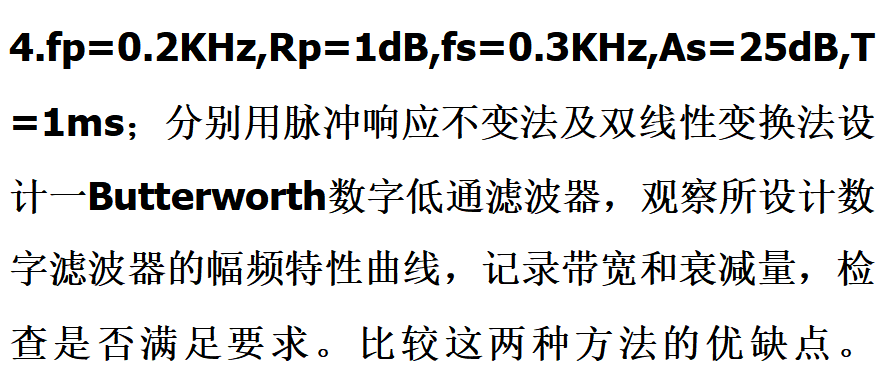
%实验三(4) 冲激响应不变法与双极性变换法的对比 clc; close all; fp=200;fs=300;Rp=1;As=25;T=0.001; %使用脉冲响应不变法(存在频率混叠) wp=2*pi*fp*T;ws=2*pi*fs*T; %wp、ws为数字频率 Wp=wp/T;Ws=ws/T; %Wp、Ws为模拟频率 [N1,fc]=buttord(Wp,Ws,Rp,As,'s'); [b,a]=butter(N1,fc,'s'); [b1,a1]=impinvar(b,a,1/T); %冲击响应不变法变换到数字滤波器 [h1,w]=freqz(b1,a1); %使用双极性变换法(不存在频率混叠) Wp=2/T*tan(wp/2);Ws=2/T*tan(ws/2); %频率预畸变 [N1,fc]=buttord(Wp,Ws,Rp,As,'s'); [b,a]=butter(N1,fc,'s'); [b2,a2]=bilinear(b,a,1/T); %双极性变换法变换到数字滤波器 [h2,w]=freqz(b2,a2); f=w/2/pi/T; figure plot(f,abs(h1),'-.',f,abs(h2),'-'); text(90,0.66,'脉冲响应不变法\rightarrow'); text(250,0.46,'\leftarrow双极性变换法'); axis([0,500,0,1]);grid on; xlabel('频率/Hz');ylabel('幅度');
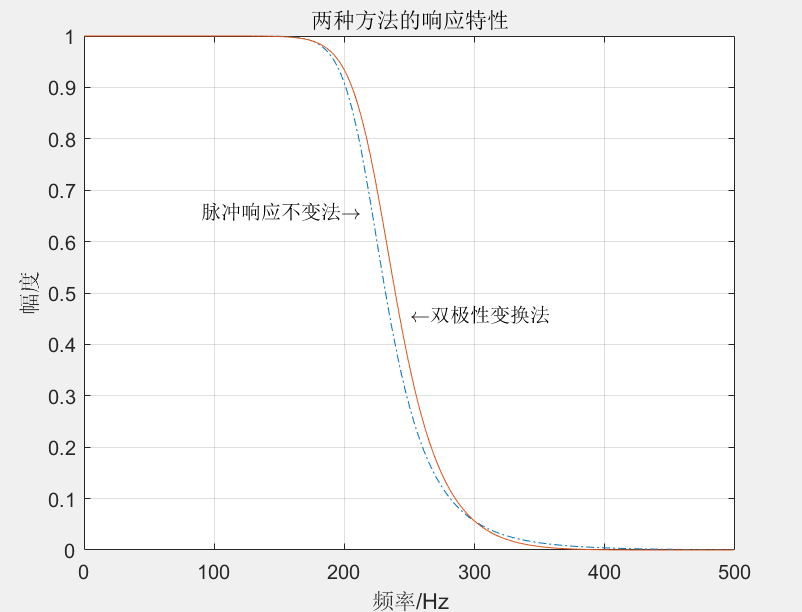





 浙公网安备 33010602011771号
浙公网安备 33010602011771号